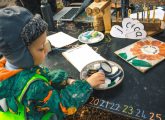Lynnette Brock explores how we identify schemes in play, and scaffold children’s learning opportunities…
Schemes are often referred to as ‘patterns of repeatable actions/ behaviours’ (Athey, 2007:114). The early scheme operations in young children’s play are the foundations – the pre-requisite skills – to later complex operations, such as reading, writing and adding, and everyday operations such as driving and cooking (Siraj-Blatchford and Brock, 2016).
Operational schemes also enable us to make sense of the objects, images and words around us; the figurative schemas. For example, a young child might recall, draw and discuss what a watering can is.
But they will only be able to do so if they have used a watering can or seen one being used; they have had first-hand experience of the operations of a watering can – to contain and pour water from (containing and trajectory scheme applications). Every golden nugget of knowledge has two parts – a schema (figurative knowledge) and a scheme (operational knowledge).
Tune into how children are applying schemes and offer a range of objects and contexts to support their interests. Anchor investigations and learning extensions in the child’s schemes (what they can already do), so that new learning is within their reach.
The child can see for themselves that there is something they feel confident to do in the new activity offered, and this empowers them to take on the risk of the ‘new’ – to be motivated to engage in new challenges.
Schemes are best observed when babies and young children are given opportunities to lead their own play.
During child-led, free-flow play provide resources across a range of contexts for children to apply their schemes to, and support this with timely and appropriate guided activities to extend their investigations. Here are a few of the most commonly observed schemes in young children’s play:
Trajectory: This is an interest in lines (vertical, horizontal and diagonal). Babies exploring this scheme might be observed kicking, reaching for objects, or visually following an adult’s movements.
Young children might enjoy dancing with scarfs and throwing balls, as well as moving their bodies in a variety of ways (up, down, backwards and forwards), including moving their feet and hands up and down in paint.
They will also be keen to get moving – crawling up and down ramps, and they might find lining-up objects in vertical or horizontal lines or dropping objects from a platform a huge fascination.
Rhymes and stories with props will support these interests, such as the rhyme ‘Hickory Dickory Dock’, with a toy mouse that runs up and down the clock.
Containing and enclosing: Children applying a containing scheme are often observed continually putting things into and out of different types of containers – the fascination is the inside, outside and the barrier between the two (Siraj-Blatchford & Brock, 2021).
Treasure baskets can facilitate early independent exploration of this. Different types of containers; fluid objects such as ribbons, socks and fabrics; and solid objects such as small balls, blocks and bangles, all facilitate the child’s exploration of how objects fit (or do not) into containers (early exploration of capacity).
Supply baskets, buckets, bags, carts and boxes for children to explore. Add groups of objects, so they can enjoy filling and emptying the containers.
Provide opportunities for children to contain themselves, for example with cardboard boxes or tents, (discovering how they fit – further exploring the inside, the outside and the barrier between the two).
Transporting: In the transporting scheme, “A child may move objects or a collection of objects from one place to another, perhaps using a bag, pram or truck” (Athey, 2007).
The transporting scheme often develops after the child has applied the trajectory and containing schemes in a variety of contexts and they now draw upon these two competencies to explore how they can be combined.
In combining them, the child may start to explore quantity, space, volume, size, weight and other material characteristics of the objects being moved from one destination to another (Brock, 2022).
They might also explore spatial awareness, journeys/mapping, orientation and start to develop some appreciation of force, momentum, inertia and friction. Children learn as they follow particular patterns of behaviour.
It’s exciting for us to find out what their investigations are and then to let children know that what they have found out is important, and there is more discover.
Lynnette Brock is Director of SchemaPlay Community Interest Company. SchemaPlay Community Interest Company provides early years SchemaPlay™ training.

Outdoor maths activities – Marvellous muddy maths ideas
Editors picks

Easy ways to support mark making in the early years
Editors picks
